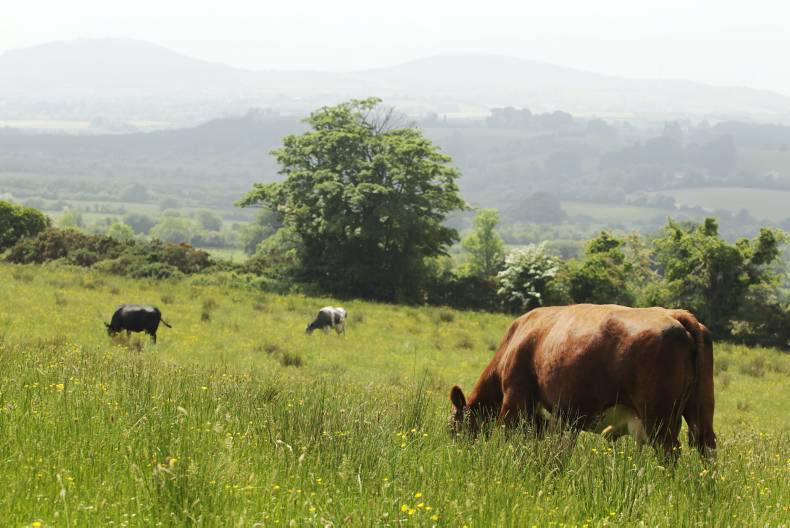With grazing season well under way, Animal Health Ireland (AHI) focuses on parasite control in this month’s bulletin.
Parasites such as gastrointestinal and lung worms, infective cysts of the liver fluke and rumen fluke can individually or collectively cause poor production and ill-thrift at best and mortality at worst.
AHI says that some farmers may have already taken measures to limit the impact of parasites, such as vaccinating for lungworm, utilising silage ground as relatively low-worm-challenge pasture or strategic treatment with anthelmintics to reduce the contamination of fields with worm eggs and larvae.
“In spring-calving beef herds, calves normally do not require any anthelmintic treatment for gut worms before weaning as their herbage intake is relatively low compared with their milk intake. Furthermore, milk itself has some protective effect against worms in the abomasum.
“The same cannot be said of lungworm, which can strike at any time and seems to have a knack of circumventing any of the barriers – anthelmintics, pasture management or vaccination – that we try to put in its way. Having said that, it is more common in the second half of the grazing season and in calves after weaning, but lungworm can also affect older animals including beef cattle and dairy cows,” AHI advises.
Vaccination and housing
Unless spring-born calves are kept inside for several months, AHI says that it is difficult to incorporate lungworm vaccination into normal farm management, although some studies in Ireland have shown that calves can be vaccinated at pasture. However, if farms have serious problems with hoose in older cattle, then vaccination can be given prior to turnout in second-grazing season cattle and adult cows.
Whatever preventative measures are in place for lungworm, vigilance is the key word and if an outbreak occurs, anthelmintic treatment should be instigated immediately and, if possible, cattle moved to another pasture (or inside if feasible).
The reason AHI gives is that contamination of a pasture with lungworm larvae can occur rapidly, remaining a high risk for several weeks thereafter. Like many aspects associated with lungworm, the outcome of treatment can be unpredictable, but providing cases are not too advanced, response to treatment is usually good. It must be remembered though that hoose is a potentially fatal condition and it may also be necessary to treat with anti-inflammatories.
To see AHI’s library of leaflets on parasite control at grazing, click here.
Read more
Vet’s corner: top tips for a dosing strategy
Coughing cows – is it lungworm, IBR or what?
With grazing season well under way, Animal Health Ireland (AHI) focuses on parasite control in this month’s bulletin.
Parasites such as gastrointestinal and lung worms, infective cysts of the liver fluke and rumen fluke can individually or collectively cause poor production and ill-thrift at best and mortality at worst.
AHI says that some farmers may have already taken measures to limit the impact of parasites, such as vaccinating for lungworm, utilising silage ground as relatively low-worm-challenge pasture or strategic treatment with anthelmintics to reduce the contamination of fields with worm eggs and larvae.
“In spring-calving beef herds, calves normally do not require any anthelmintic treatment for gut worms before weaning as their herbage intake is relatively low compared with their milk intake. Furthermore, milk itself has some protective effect against worms in the abomasum.
“The same cannot be said of lungworm, which can strike at any time and seems to have a knack of circumventing any of the barriers – anthelmintics, pasture management or vaccination – that we try to put in its way. Having said that, it is more common in the second half of the grazing season and in calves after weaning, but lungworm can also affect older animals including beef cattle and dairy cows,” AHI advises.
Vaccination and housing
Unless spring-born calves are kept inside for several months, AHI says that it is difficult to incorporate lungworm vaccination into normal farm management, although some studies in Ireland have shown that calves can be vaccinated at pasture. However, if farms have serious problems with hoose in older cattle, then vaccination can be given prior to turnout in second-grazing season cattle and adult cows.
Whatever preventative measures are in place for lungworm, vigilance is the key word and if an outbreak occurs, anthelmintic treatment should be instigated immediately and, if possible, cattle moved to another pasture (or inside if feasible).
The reason AHI gives is that contamination of a pasture with lungworm larvae can occur rapidly, remaining a high risk for several weeks thereafter. Like many aspects associated with lungworm, the outcome of treatment can be unpredictable, but providing cases are not too advanced, response to treatment is usually good. It must be remembered though that hoose is a potentially fatal condition and it may also be necessary to treat with anti-inflammatories.
To see AHI’s library of leaflets on parasite control at grazing, click here.
Read more
Vet’s corner: top tips for a dosing strategy
Coughing cows – is it lungworm, IBR or what?






 This is a subscriber-only article
This is a subscriber-only article










SHARING OPTIONS: